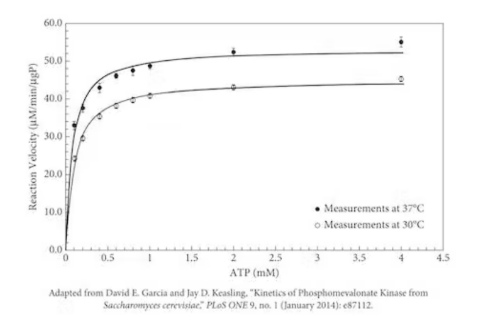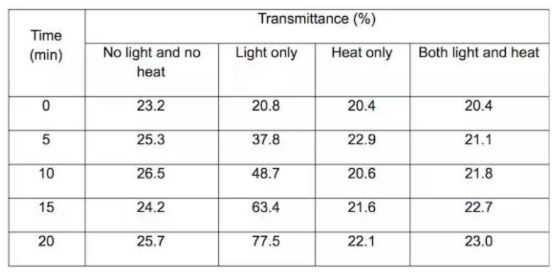AP Biology Practice Questions
/in AP Biology /by adminFREE PREMIUM CONTENT
AP Biology Equations & Formulas Sheet
Download a free list of equations and formulas you should know for the AP Bio exam!
AP Biology Free Practice Question #1
Researchers studied the activity of mevalonate kinase, an enzyme that may be important for biofuel production. The graph below shows the rate of a reaction as the concentration of ATP is increased while substrate concentration remains constant. The open circles represent data points collected at 30°C and the closed circles represent data points collected at 37°C.

1. How is the reaction between enzyme and substrate modified by the different temperatures?
(A) At 30°C, the substrate molecules have less kinetic energy than at 37°C. This reduces the rate of random collisions and therefore the rate of the reaction.
(B) At 30°C, the substrate molecules have more kinetic energy than at 37°C. The excess kinetic energy makes it harder for the substrate to bind to the enzyme.
(C) At 37°C, the enzymes have formed the correct shape to maximize the reaction rate. At 30°C, the enzymes have denatured due to excess heat and the substrates have more difficulty binding to the active site.
(D) At 37°C, the concentration of the substrates is higher than at 30°C. This allows the reaction to proceed more rapidly.
Answer 1
The answer is (A): A certain amount of energy (the activation energy) is needed for the reaction to take place. At higher temperatures, there is more kinetic energy and the increased rate of random collisions between molecules increases the probability that they will collide in the right way to react. Thus, (A) correctly characterizes this relationship. (B) is incorrect because there is more kinetic energy at higher temperatures, not at lower temperatures, and because increased kinetic energy actually raises the likelihood that the substrate will bind to the enzyme. (C) is incorrect because 30°C is actually a higher temperature than 37°C, so it makes no sense to say that the protein “denatured due to excess heat.” (D) is incorrect because substrate concentration remains constant, according to the question stem.
AP Biology Free Practice Question #2

Dichlorophenolindophenol (DPIP), an electron acceptor that changes from blue to clear when reduced, can be used to visually determine the rate of photosynthesis. In an experiment, a solution of chloroplasts containing DPIP was divided among 4 tubes. The samples were then exposed to light (1500 lumens) and/or heat (85oC), and light transmittance was measured over time using a spectrophotometer. Higher transmittance is correlated to lighter color. The results of the experiment are provided.
2. Which of the following can be reasonably concluded from the experimental results?
(A) The onset of photosynthesis is visible when DPIP is oxidized and changes from clear to blue.
(B) Chloroplasts exposed to heat had the highest rate of photosynthesis.
(C) Photosynthesis is stimulated when chloroplasts are exposed to light only.
(D) The solution in all four tubes was clear at time 0.
Answer 2
The answer is (C): DPIP acts as a substitute for NADP+ in photosynthesis. During photosynthesis, DPIP is reduced and becomes colorless, which results in an increase in light transmittance. According to the data, an increase in light transmittance over time is found for the tube exposed to light only. The correct answer is (C). Choice A is incorrect because DPIP changes from blue to clear when reduced during photosynthesis. Choice B is incorrect because the tube exposed to light only had the highest rate of photosynthesis (increasing percent transmittance). Choice D is incorrect because the solution in all four tubes was blue at time 0.
AP Biology Free Practice Question #3
In an emergency, a doctor can replace a patient’s blood plasma with a solution of 5% human albumin and 0.9% NaCl. A pharmacist does not have ready-made 5% albumin solution and decided to use a 25% albumin solution instead. He mixed 1 part of the 25% solution with 4 parts of sterile distilled water.
3. The administration of the solution caused severe damage to the patient. How can the consequence of the administration of substitute plasma be explained?
(A) The dilution was incorrect, resulting in an excessive concentration of albumin that led to the shriveling of the red blood cells.
(B) The dilution was incorrect, resulting in a deficient concentration of albumin that led to the bursting of the red blood cells.
(C) The dilution of albumin in distilled water caused the bursting of red blood cells because the solution was hypotonic to the red blood cells.
(D) The dilution of albumin in distilled water caused the shriveling of the red blood cells because the solution was hypertonic to the red blood cells.
Answer 3
The answer is (C): The pharmacist’s dilution of albumin was correct: when a solution of 25% albumin is diluted to contain five times as much water, it will have one-fifth of the original concentration, or 5% albumin. However, the pharmacist should have used sterile saline solution instead of the distilled water, to ensure that there was an adequate concentration of NaCl. Because the resulting solution was hypotonic to the red blood cells, water from the solution osmosed into the cells, causing them to burst, as in (C). (A) and (B) are incorrect because the pharmacist did not err in his dilution of the albumin. (D) is incorrect because the solution is hypo- tonic to the red blood cells, not hypertonic.
AP Biology Free Practice Question #4
Lactose fermenting strains of Streptococcus pneumoniae are designated as lac+, whereas strains deficient in lactose fermentation are designated as lac–. Extracts from lac+ cells are incubated separately with three different enzymes: extract A with protease K (which digests proteins), extract B with DNases (which digests DNA), and extract C with RNase H (which digests RNA). After treatment with enzymes, each extract is incubated with live lac− cells and grown on a medium containing an indicator. Blue colonies indicate that lactose is being fermented. Colorless colonies indicate that the cells cannot ferment lactose.
4. Which of the following would most likely be observed after growing the cultures?
(A) Only colorless colonies appear from cells incubated with extract A.
(B) Only colorless colonies appear from cells incubated with extract B.
(C) Only colorless colonies appear from cells incubated with extract C.
(D) Blue colonies appear from cells grown with all three extracts.
Answer 4
The answer is (B): Because the lac− cells contain everything necessary to construct enzymes that can ferment lactose except for the DNA with the lac+ genes, the only cells that would be adversely affected would be those incubated with extract B, which loses those genes due to the action of the DNases. Because those cells would be unable to ferment lactose, they would appear as colorless. (B) is thus correct. (A) is incorrect because the lac− cells contain all the proteins and amino acids necessary to construct lactose-fermenting enzymes, provided they have the proper genes (which they can get from extract A), so they would appear blue. (C) is incorrect because the lac− cells contain all the RNA molecules and nucleotides necessary to transcribe and translate the lactose-fermenting enzymes, provided they have the proper genes (which they can get from extract C), so they would also appear blue. (D) is incorrect because the cells incubated with extract B will appear colorless, as explained above.
AP Biology Free Practice Question #5
In a respiration experiment, transgenic mice (those possessing a particular genetic mutation) were compared to wild type (normal) mice. The ADP levels in the transgenic mice were found to be higher than those in the wild type.
5. Which of the following is the most plausible explanation for this finding?
(A) The rate of oxygen consumption in mitochondria was higher in transgenic mice.
(B) The transgenic mice are unable to utilize ATP in the cytoplasm for metabolism.
(C) The transgenic mice have impaired mitochondria, decreasing their cells’ ability to convert ADP to ATP.
(D) The rate of carbon dioxide consumption in cells was lower in transgenic mice.
Answer 5
The answer is (C): Aerobic phases of cellular respiration in eukaryotes occur in mitochondria, which synthesize ATP from ADP. Higher than normal levels of ADP suggest that the transgenic mice are unable to convert ADP to ATP as efficiently because the mutation has impaired their mitochondria. The correct answer is (C). Choice A is incorrect because a higher rate of oxygen consumption in mitochondria would decrease ADP levels (electrons are transferred to oxygen when ADP is phosphorylated to make ATP). Choice B is incorrect because ADP levels would be greater when ATP is utilized (ATP → ADP + Pi). Choice D is incorrect because carbon dioxide is released, not consumed, in cellular respiration.
Click here for more AP Biology practice questions.
